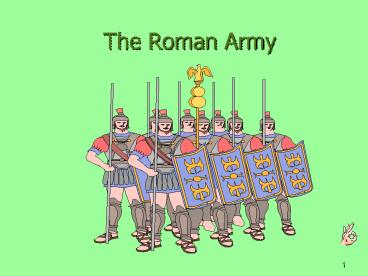The Roman Army - PowerPoint PPT Presentation
1 / 17
Title:
The Roman Army
Description:
Write an advertisement to attract young Roman men into the Roman army. Use the information on these ... This was called a testudo, which means tortoise. 16 ... – PowerPoint PPT presentation
Number of Views:533
Avg rating:1.0/5.0
Title: The Roman Army
1
The Roman Army
2
ROMAN ARMY RECRUITMENT CENTRE
Write an advertisement to attract young Roman men
into the Roman army. Use the information on these
slides to take notes for the poster. After the
last slide, number 17, start making your final
copy.
3
Who Was In the Army?
- The Roman Army was made up of men from all over
the Empire, no women were allowed to join. - These men were professional soldiers whose only
job was to fight and defend Rome. - Initially only property owners such as farmers
could serve in the army, but from the 1st century
B.C. onwards anybody could join. - These soldiers would have to stay in the army for
at least 25 years!
4
How to become a Legionary!
- You had to be a Roman citizen
- You had to be physically fit and 1.6m tall
- You were expected to stay in the army for 25 years
5
Training
- Most soldiers joined between 18-20 years old
- There were three 30km marches each month
- On each march the legionary would carry 25 kilos
of equipment
6
How the Roman Army was organised
- The army was made up of legions.
- Each legion was divided into ten cohorts
- Each cohort was made up of six centuries
- The centuries were commanded by a centurion
- Centuries originally had 100 men, but it got
fewer in time.
7
- The centurions were very important men
- They were responsible for training the soldiers
under their command and making sure everyone
obeyed orders. - Some were very cruel
8
- There were also other kinds of soldiers called
auxiliaries who included the cavalry. - To show the differences in ranks centurions
carried a special stick to show who they were. - They used the stick to beat any soldier who
disobeyed an order. - The important centurions also wore special
armour, which emphasised their rank.
9
Auxiliaries were often soldiers from lands
conquered by the Romans who volunteered to fight
for the Romans. Most were archers. They were
usually thought of by Romans as second class
soldiers, paid less and not trained as
rigorously. After 25 years- they and their
families were granted Roman citizenship.
10
Discipline Centurions were in charge of
discipline. They carried a stick of very hard
wood and they used it to beat their soldiers.
They used to punish even small things with extra
duties, flogging or a fine. The men earned 2
1/2 pence a day. Serious infringements of
discipline, like mutiny, were punished by
decimation- the centurion walked along the lines
of soldiers touching every tenth man who was
killed, sometimes by stoning.
11
- Uniforms and Equipment
- Roman soldiers wore leather sandals on their
feet. - They wore a wool tunic and leather breeches
around their legs and they wore shoulderplates to
shield their shoulders. - A roman shield (scutum) was curved to fit around
the body and their helmet was made of bronze to
protect their heads.
12
They also carried a sword (a gladius), a shield,
two javelins and a dagger for close fighting.
When the javelin hit an enemy's shield
it bent making it very difficult to pull out.
The shaft would drag on the ground and trip up
the man who would then have to throw his shield
away.
13
Standard Bearers
- Each century had its own emblem or standard.
- This was carried by the standard bearer, a very
experienced and trusted soldier - To lose your standard was a great disgrace
14
Design your own centuries standard. Make the
whole thing a whole jotter page tall. The
elements in the design must be meaningful to you,
like part of your history or culture. Use no more
than FOUR different colours, not counting the
plain, self-coloured background!
15
What was life like in the Roman Army?
- Roman soldiers had to be tough. They
were expected to march 20 miles a day wearing
armour. - They were also expected to carry their own
shield, some food and camping equipment. - Soldiers were also trained to fight together.
They marched into battle in a flexible line with
their shields next to each other. - If the enemy shot arrows at them the soldiers in
the rows behind the front line would lift their
shields over their heads like a roof to protect
them. This was called a testudo, which means
tortoise.
16
- Legionaries would also learn drill, or marching
- This was important for learning manoeuvres in
battle - New recruits were given shields and swords twice
as heavy as the real thing!
17
At its finest period the Roman army was almost
unconquerable. There were three main reasons for
this Discipline Hard and efficient training
The speed at which they learnt new tactics
TERMINUS































